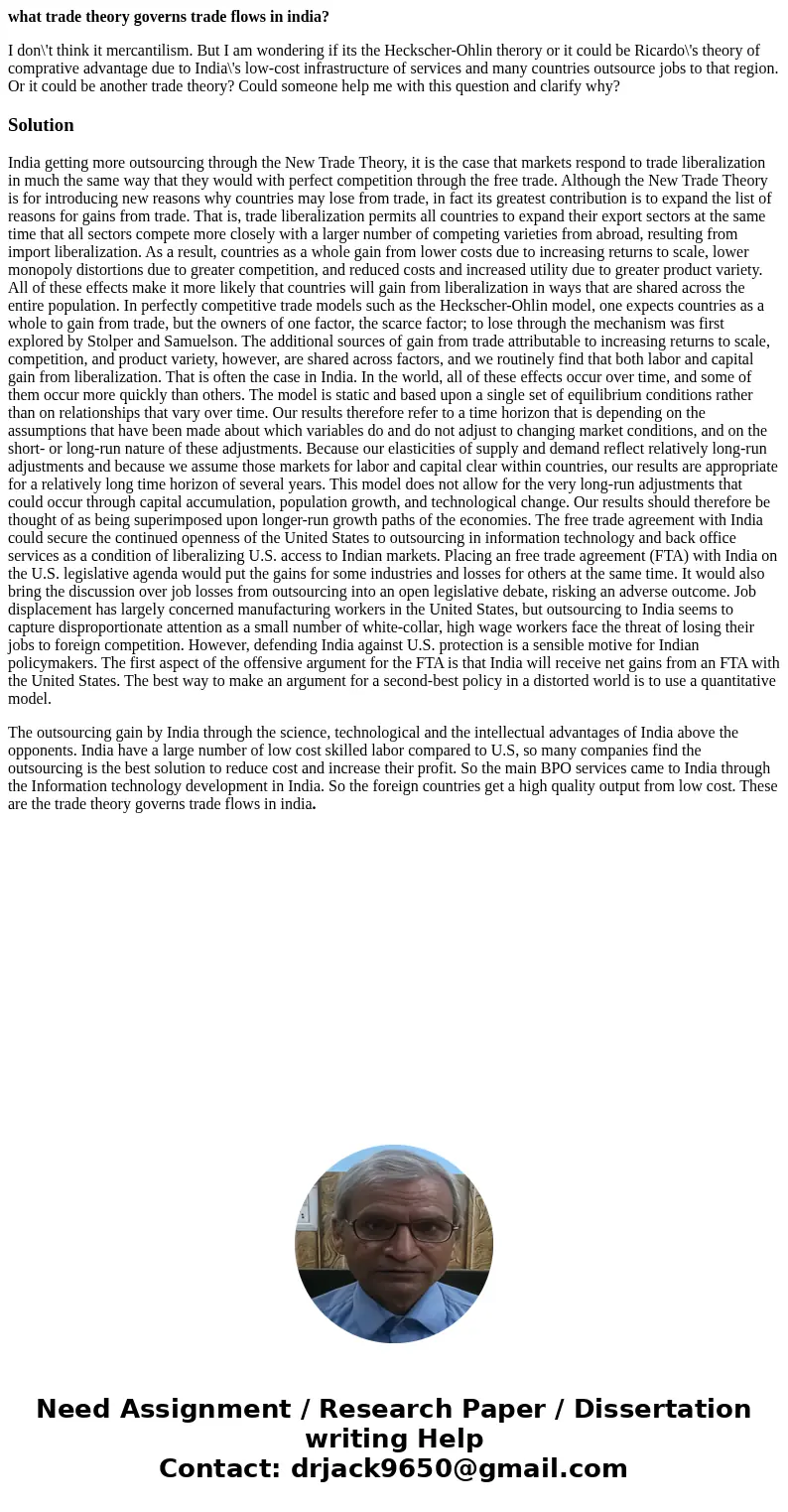what trade theory governs trade flows in india I dont think
what trade theory governs trade flows in india?
I don\'t think it mercantilism. But I am wondering if its the Heckscher-Ohlin therory or it could be Ricardo\'s theory of comprative advantage due to India\'s low-cost infrastructure of services and many countries outsource jobs to that region. Or it could be another trade theory? Could someone help me with this question and clarify why?
Solution
India getting more outsourcing through the New Trade Theory, it is the case that markets respond to trade liberalization in much the same way that they would with perfect competition through the free trade. Although the New Trade Theory is for introducing new reasons why countries may lose from trade, in fact its greatest contribution is to expand the list of reasons for gains from trade. That is, trade liberalization permits all countries to expand their export sectors at the same time that all sectors compete more closely with a larger number of competing varieties from abroad, resulting from import liberalization. As a result, countries as a whole gain from lower costs due to increasing returns to scale, lower monopoly distortions due to greater competition, and reduced costs and increased utility due to greater product variety. All of these effects make it more likely that countries will gain from liberalization in ways that are shared across the entire population. In perfectly competitive trade models such as the Heckscher-Ohlin model, one expects countries as a whole to gain from trade, but the owners of one factor, the scarce factor; to lose through the mechanism was first explored by Stolper and Samuelson. The additional sources of gain from trade attributable to increasing returns to scale, competition, and product variety, however, are shared across factors, and we routinely find that both labor and capital gain from liberalization. That is often the case in India. In the world, all of these effects occur over time, and some of them occur more quickly than others. The model is static and based upon a single set of equilibrium conditions rather than on relationships that vary over time. Our results therefore refer to a time horizon that is depending on the assumptions that have been made about which variables do and do not adjust to changing market conditions, and on the short- or long-run nature of these adjustments. Because our elasticities of supply and demand reflect relatively long-run adjustments and because we assume those markets for labor and capital clear within countries, our results are appropriate for a relatively long time horizon of several years. This model does not allow for the very long-run adjustments that could occur through capital accumulation, population growth, and technological change. Our results should therefore be thought of as being superimposed upon longer-run growth paths of the economies. The free trade agreement with India could secure the continued openness of the United States to outsourcing in information technology and back office services as a condition of liberalizing U.S. access to Indian markets. Placing an free trade agreement (FTA) with India on the U.S. legislative agenda would put the gains for some industries and losses for others at the same time. It would also bring the discussion over job losses from outsourcing into an open legislative debate, risking an adverse outcome. Job displacement has largely concerned manufacturing workers in the United States, but outsourcing to India seems to capture disproportionate attention as a small number of white-collar, high wage workers face the threat of losing their jobs to foreign competition. However, defending India against U.S. protection is a sensible motive for Indian policymakers. The first aspect of the offensive argument for the FTA is that India will receive net gains from an FTA with the United States. The best way to make an argument for a second-best policy in a distorted world is to use a quantitative model.
The outsourcing gain by India through the science, technological and the intellectual advantages of India above the opponents. India have a large number of low cost skilled labor compared to U.S, so many companies find the outsourcing is the best solution to reduce cost and increase their profit. So the main BPO services came to India through the Information technology development in India. So the foreign countries get a high quality output from low cost. These are the trade theory governs trade flows in india.

 Homework Sourse
Homework Sourse